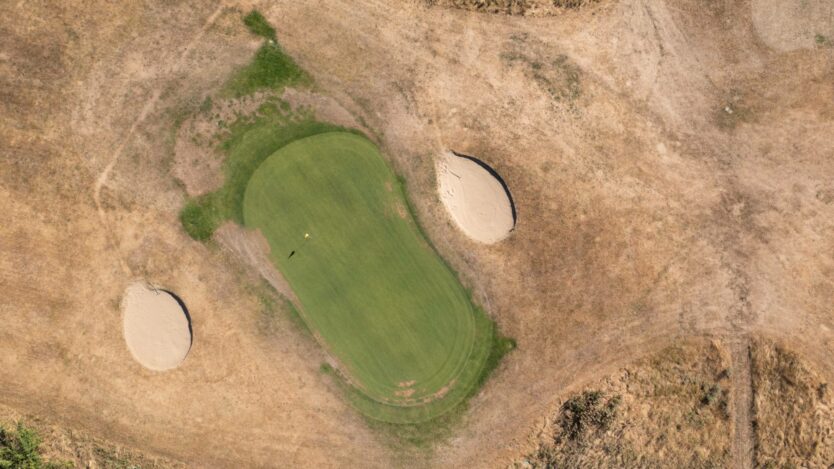As eight areas of England are declared to be in drought and more water companies announce hosepipe bans, strategic partners Rain Bird and STRI Group offer practical advice to courses – while GCMA chief executive Tom Brooke and BIGGA CEO Jim Croxton outline their thoughts…
GCMA strategic partners Rain Bird and STRI Group have come together to issue practical advice on how golf courses can deal with the extreme weather conditions in the UK.
Their guidance comes as GCMA chief executive Tom Brooke, and BIGGA CEO Jim Croxton, issued a statement calling on the golf industry to ensure that “we as a sport are doing our bit to limit water usage”.
A drought has now been declared across eight areas of England and temporary use bans continue to be announced by water companies.
The pair said: “Golf provides physical exercise and social interaction for more than 5,000,000 people in the UK and as a business generates an estimated turnover in excess of £10 billion whilst providing employment for around 100,000 individuals.
“The golf course is the central element to any golf facility and well managed and maintained surfaces are essential to the playing of the game.
“In order for this to continue in warm or hot weather irrigation is critical to ensure the grass plant survives.
“With the above in mind, we must very carefully consider the ongoing and sustainable management of our golf courses, whilst at the same time focussing on priority playing areas and ensuring that we are not exceeding licenced water usage or infringing on any legally enforced restrictions.
“Management of golfer expectations is, of course, going to be a challenge. Golf club members and visitors are used to seeing green playing surfaces and it is important that we develop an understanding that under the current circumstances, this is quite simply not possible, and we need to ask our members and visiting golfers to be considerate of this.
“As a sport and as an industry, we also have a social responsibility to consider and therefore we must all work together to ensure that golf clubs as a whole are working within the current restrictions and that we as a sport are doing our bit to limit water usage as much as is reasonably practical at the current time.”
The association will be running a short series of webinars, starting with Drought Mitigation on Tuesday, at 3pm, which will discuss the rapidly changing situation and the challenges dealing with the short, medium, and longer-term picture. In the meantime, Rain Bird and STRI Group have advised the following…
When irrigating
- Balance irrigation requirements against the available water supply: Understand your abstraction rates or inflow available to refill your day tank and ensure licences are not exceeded. Record irrigation usage and demonstrate sound stewardship. Take care not to infringe any temporary restrictions or advisory notices (such as hours of the day when watering isn’t permitted) as required by your regional water authority.
- Prioritise greens: Aim to maintain turf health and avoid turfgrass diseases and disorders in the wetter or average areas of your greens. Do not irrigate to serve dry or high spots and hand water dry areas.
- Irrigate at the optimal time: This is generally the early hours of the morning. Wind speeds are usually lower, and you avoid creating humid turf conditions by keeping turf too wet overnight and losing water through evapotranspiration.
- Carry out a visual check using H-A-P-N-A:
Height – are your rotors (sprinklers) at the correct height to achieve the intended range of throw?
Angle – are your rotors level? Unevenness can affect water distribution efficiency.
Pressure – is there sufficient pressure to operate your rotors effectively? Low pressure will effect overall coverage and prevent head to head coverage. Pressure that is too high pressure may cause the water to atomize offering little benefit to the turf.
Nozzle – is the correct nozzle being used in the rotor to achieve the required coverage?
Arc – have arcs been adjusted to ensure only the required area is irrigated?
- Make full use of your system’s water efficiency features: Ensure every drop applied benefits the turf. If you need any assistance setting these up, contact your irrigation contractor or system manufacturer.
On the course
- Spot check moisture readings: Use an accurate soil moisture probe if available. Measure moisture content during the morning and the afternoon to better understand the dry down and rewetting to ensure the correct amount of water is being applied.
- Reduce turfgrass stress pressures: Avoid undertaking work, including mowing, if temperatures exceed 30°c, particularly in unirrigated areas.
- Make use of appropriately selected turf surfactants (wetting agents): These aid the infiltration of applied water and improve soil’s ability to maintain uniform moisture balance. Ensure you follow the manufacturer’s application instructions.
- Spread the wear: Ensure physical stress isn’t confined to one area by moving pin locations.
- NOW READ: What is the latest on hosepipe bans?
Do you subscribe to the GCMA’s weekly E-newsletter? Make sure you’re not missing out on the latest in the world of golf club management. Click here to join in.



